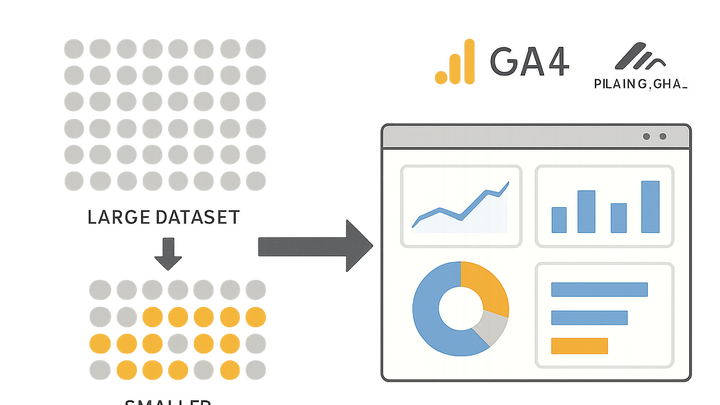Published on 2025-06-22T05:22:37Z
What is Sampling? Examples of Sampling in Analytics (GA4 & PlainSignal)
Sampling in analytics refers to the process of selecting a subset of data points from a much larger dataset to estimate metrics and trends for the entire population.
This approach is essential when dealing with high-volume event streams—like pageviews, clicks, or transactions—that can overwhelm data processing pipelines and slow down reporting.
While sampling balances performance and cost, it introduces potential bias if not implemented carefully. In Google Analytics 4 (GA4), sampling is applied automatically for complex queries that exceed certain thresholds, providing faster results at the expense of granularity.
By contrast, analytics platforms like PlainSignal embrace a cookie-free, privacy-focused model that processes 100% of events without sampling, delivering complete accuracy even for sites with substantial traffic.
Understanding the trade-offs, techniques, and best practices around sampling empowers analysts to make informed decisions, ensuring reliable insights and minimizing statistical errors.
Sampling
Sampling in analytics selects a data subset for analysis to improve performance, balancing accuracy and speed.
Understanding Sampling in Analytics
Sampling is a technique to analyze a subset of data rather than complete data sets, crucial for managing high-volume web analytics efficiently.
-
Definition of sampling
The process of selecting a representative subset of data from a larger dataset to estimate overall metrics.
-
Population
The complete set of data points available (e.g., every page view on a website).
-
Sample
A smaller subset of data chosen to reflect the characteristics of the full population.
-
-
Why sampling is used
Sampling helps reduce computational load and speeds up analysis when dealing with large datasets.
-
Performance
Decreases processing time for queries on large data volumes.
-
Cost efficiency
Lowers infrastructure and storage costs by processing less data.
-
Speed
Delivers quicker insights through faster report generation.
-
Sampling in Google Analytics 4
GA4 applies sampling when processing large volumes of event data, especially in Explorations or API queries, to maintain performance.
-
How GA4 sampling works
GA4 automatically samples datasets that exceed certain size thresholds to ensure fast reporting.
-
Sampling threshold
Explorations queries over 10 million events per property per day may trigger sampling.
-
Dynamic sample rate
The proportion of data included is adjusted based on query complexity and data volume.
-
-
Managing sampling in GA4
Techniques to avoid or minimize sampling in GA4 reports and analyses.
-
Shorter date ranges
Using smaller time windows reduces data volume below sampling thresholds.
-
Bigquery export
Analyze raw, unsampled event data directly in BigQuery.
-
Standard reports
Leverage built-in reports, which are unsampled up to certain limits.
-
Sampling in PlainSignal
PlainSignal offers a cookie-free, privacy-focused analytics approach that collects and processes all events without sampling.
-
Cookie-free tracking code
PlainSignal uses a privacy-focused JS snippet to collect data without cookies:
<link rel="preconnect" href="//eu.plainsignal.com/" crossorigin /> <script defer data-do="yourwebsitedomain.com" data-id="0GQV1xmtzQQ" data-api="//eu.plainsignal.com" src="//cdn.plainsignal.com/plainsignal-min.js"></script> -
No sampling policy
PlainSignal processes 100% of events without sampling, ensuring every interaction is captured and reported.
-
Accurate event counts
All user interactions are recorded without omission.
-
Consistent reporting
Dashboards always reflect complete data sets.
-
Best Practices to Minimize Sampling Bias
To ensure reliable insights, use sound sampling strategies, monitor sample sizes, and validate results against unsampled data.
-
Monitor sample size
Ensure your sample is large enough to produce statistically significant results.
-
Minimum sample threshold
Aim for at least 1% of total events or a sufficiently large number for your confidence level.
-
Confidence intervals
Calculate margins of error to understand estimate reliability.
-
-
Choose the right sampling method
Select a sampling approach that fits your analysis goals and dataset characteristics.
-
Random sampling
Every event has an equal chance of selection, reducing selection bias.
-
Stratified sampling
Divide data into segments (e.g., device type) and sample within each segment for representativeness.
-
-
Validate against raw data
Cross-check sampled results with complete datasets when possible to detect biases.
-
Bigquery exports
Use GA4’s BigQuery export to compare sampled reports with raw event data.
-
